L
Luke Wilkinson
Guest
Volkswagen has expanded the ID.3 range again, adding an entry-level Pure Performance powertrain. The new motor and battery pack means ID.3 pricing now starts from £28,370 (after the government grant), giving Volkswagen a closer rival for the Nissan Leaf.
The ID.3’s new powertrain comprises a 45kWh battery pack and a 148bhp electric mounted on the rear axle. Volkswagen says it’ll deliver 217 miles of range and a 0-62mph time of 8.9 seconds. Like the rest of the ID.3 line-up, the car’s top speed is limited to 99mph.
When connected to a 100kW DC rapid charger, the ID.3’s new 45kWh battery will regain 137 miles of range in 30 minutes, while an 80 per cent charge using a 7.2kW wallbox charger takes around seven and half hours.
Volkswagen’s new entry-level powertrain can be specified in two trim levels: City and Style. The former option is the cheapest and comes as standard with LED headlamps, electrically adjustable door mirrors and automatic windscreen wipers.
Inside, buyers get a 10-inch infotainment system, an auto-dimming rear-view mirror, heated front seats, a heated steering wheel and a 10-colour ambient lighting system. Buyers also get wireless Apple CarPlay and Android Auto integration, as well as voice recognition for the infotainment.
The Volkswagen ID.3 Style is priced from £32,470 after the government grant. Upgrades over the City specification include 18-inch alloy wheels, matrix LED headlamps, full keyless operation, rear privacy glass and scrolling rear indicators. The cabin gets a lift, too, with two-zone air conditioning, a rear-view camera and a 30-colour interior ambient lighting system.
Above Volkswagen’s new Pure Performance powertrain sits the firm’s Pro system, which blends a 143bhp electric motor with a larger 58kWh battery pack. Prices start from £29,170 including the government grant.
Stepping up again, there’s the Pro Performance powertrain, which uses the same 58kWh battery pack, but a more powerful 201bhp electric motor. It’s priced from £31,290 after the government’s £2,500 grant has been applied.
The only key difference between the two motors is acceleration. Pro models take 9.6 seconds to get from 0-62mph, while Pro Performance cars will cover the same sprint in 7.6 seconds. Both have a top speed of 99mph.
Both options also support 100kW DC rapid charging, which can top the battery up from five to 80 per cent full in 35 minutes. Depending on the trim-level, both cars will cover between 258 and 263 miles between recharges.
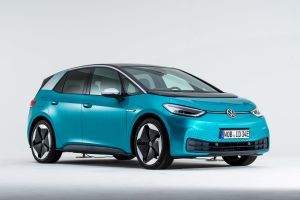
Volkswagen ID.3 - front static
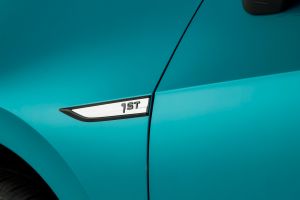
Volkswagen ID.3 - side detail

Volkswagen ID.3 - detail
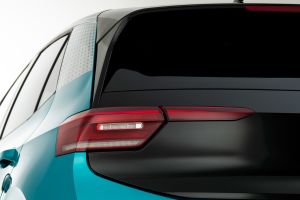
Volkswagen ID.3 - rear light

Volkswagen ID.3 - white front
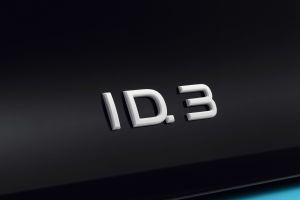
Volkswagen ID.3 - blue badge
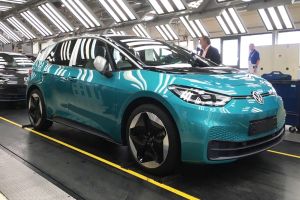
Volkswagen ID.3 - Frankfurt front
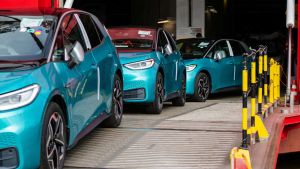
New entry-level Volkswagen ID.3 Pure Performance launched
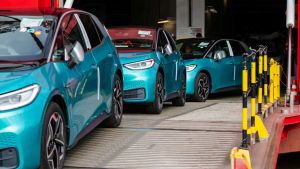
Volkswagen ID.3

Volkswagen ID.3 - front
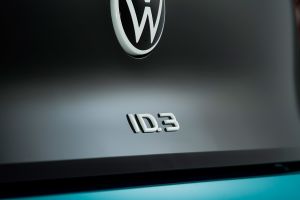
Volkswagen ID.3 - badge
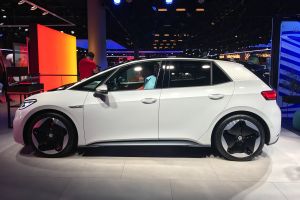
Volkswagen ID.3 - side static Frankfurt
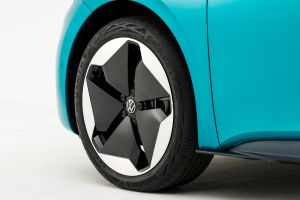
Volkswagen ID.3 - wheel
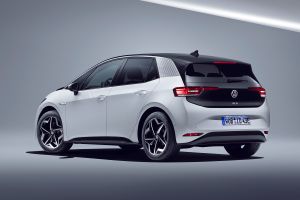
Volkswagen ID.3 - white rear
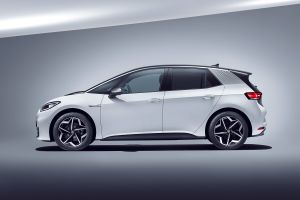
Volkswagen ID.3 - white side
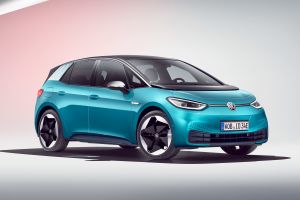
Volkswagen ID.3 - blue front
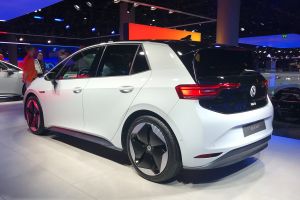
Volkswagen ID.3. - rear 3/4 static Frankfurt

VW ID.3 Pure

Volkswagen ID.3
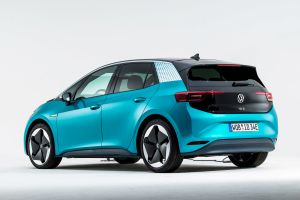
Volkswagen ID.3 - rear
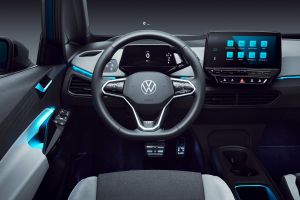
Volkswagen ID.3 - dash
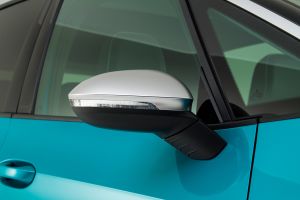
Volkswagen ID.3 - wing mirror

Volkswagen ID.3

Volkswagen ID.3
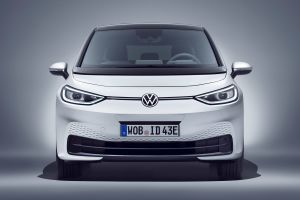
Volkswagen ID.3 - white full front

Volkswagen ID.3 - blue rear
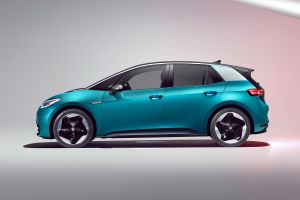
Volkswagen ID.3 - blue side

Volkswagen ID.3 - Frankfurt rear
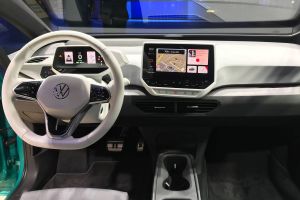
Volkswagen ID.3 - Frankfurt dash
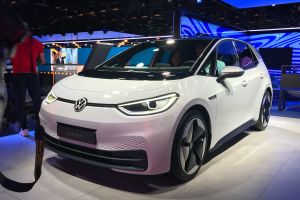
Volkswagen ID.3. - front 3/4 static Frankfurt
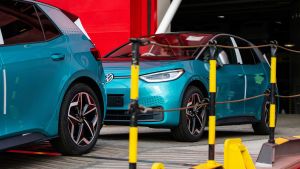
Volkswagen ID.3
The Volkswagen ID.3’s current flagship electric powertrain is called Pro S. It features the same 201bhp electric motor as the Pro Performance system, but a larger 77kWh battery pack which offers a maximum range of 336 miles.
The heavier battery dulls performance slightly, with 0-62mph taking 7.9 seconds. However, a faster 125kW charging system means that the larger bank of cells takes only slightly longer to top up. A 5-80 per cent recharge takes 38 minutes.
Prices for Volkswagen’s Pro S powertrain start from £42,600, as it’s only available on the range-topping ID.3 Tour. As such, it isn’t eligible for the government’s new plug-in car grant, meaning buyers won’t receive a £2,500 discount.
Late last year, Volkswagen also confirmed it was “actively considering” a high-performance version of the ID.3. It’ll be based on the same MEB platform as the standard car, but it’ll come with a more potent electric drivetrain and an uprated battery pack, designed using the expertise gained from the ID.R racer project.
Above the new City and Style specifications sits Volkswagen’s Life trim, priced from £29,970 including the government grant. Unlike the two cheaper models, which are only available with Volkswagen’s entry-level Pure Performance powertrain, it can be specced with the German firm’s Pro and Pro Performance set-ups.

Volkswagen ID.3 - front static

Volkswagen ID.3 - side detail

Volkswagen ID.3 - detail

Volkswagen ID.3 - rear light

Volkswagen ID.3 - white front

Volkswagen ID.3 - blue badge

Volkswagen ID.3 - Frankfurt front

New entry-level Volkswagen ID.3 Pure Performance launched

Volkswagen ID.3

Volkswagen ID.3 - front

Volkswagen ID.3 - badge

Volkswagen ID.3 - side static Frankfurt

Volkswagen ID.3 - wheel

Volkswagen ID.3 - white rear

Volkswagen ID.3 - white side

Volkswagen ID.3 - blue front

Volkswagen ID.3. - rear 3/4 static Frankfurt

VW ID.3 Pure

Volkswagen ID.3

Volkswagen ID.3 - rear

Volkswagen ID.3 - dash

Volkswagen ID.3 - wing mirror

Volkswagen ID.3

Volkswagen ID.3

Volkswagen ID.3 - white full front

Volkswagen ID.3 - blue rear

Volkswagen ID.3 - blue side

Volkswagen ID.3 - Frankfurt rear

Volkswagen ID.3 - Frankfurt dash

Volkswagen ID.3. - front 3/4 static Frankfurt

Volkswagen ID.3
Standard equipment for the ID.3 Life includes 18-inch steel wheels, LED headlights, adaptive cruise control with lane assist and parking sensors all round. The EV also supports natural voice commands and Volkswagen’s Car2X system, which can communicate with nearby Car2X-equipped vehicles to warn the driver of upcoming hazards.
Inside, the ID.3 Life gets a 10-inch infotainment system with satellite navigation, Bluetooth and smartphone connectivity. Like the ID.3 City, the Life also comes with Volkswagen’s Comfort Pack as standard, which includes electrically folding door mirrors, an auto-dimming rear-view mirror, heated seats and a heated steering wheel.
Volkswagen’s Business specification is the cut-off point for the £2,500 government grant, as it’s priced from £35,710. It builds on the Life model’s equipment, adding matrix LED lights, animated LED tail lights, rear privacy glass and customisable cabin lighting. Buyers also get a rear-view camera, keyless entry and illuminated door handles.
The ID.4 Family starts from £36,640 and comes with a couple of upgrades, such as two-zone air-conditioning and a panoramic glass sunroof. Stepping up again, the £39,500 ID.3 Tech comes with climate control and Volkswagen’s Infotainment Plus pack, which adds an uprated sound system and a head-up display with augmented reality animations.
The ID.3 Max is priced from £41,530 and offers electrically adjustable front seats with a massage function. It also introduces Volkswagen’s Sport Package, which adds progressive steering and sports suspension. At a later date, Volkswagen will launch a Plus version of the package, too, with adaptive dampers.
Currently, the top spot in the ID.3 line-up is occupied by the Tour specification. It’s priced from £42,600 and features all the aforementioned equipment, along with 19-inch alloy wheels, electric front seats and Volkswagen’s long-range Pro S powertrain.
Buyers can further customise their ID.3 with a choice of six exterior colours. All models get a contrasting black roof and boot lid, while the C-pillar can be finished optionally in either a silver or copper hue.
Different wheel designs up to 20-inches in diameter are available across the range. Three interior colour schemes are offered: white and black, white and orange or all black.
From the outside, the ID.3 sticks close to the concept that made its debut at the Paris Motor Show back in 2016. The cute headlights remain, along with the “honeycomb” motif along the front bumper and the black tailgate is also still present; this final element is destined to be an ever-present design cue on ID.3s.
The most noticeable change comes in the side profile, where Volkswagen has had to fit a longer bonnet to comply with pedestrian safety regulations. However, the company’s design team, led by Klaus Bischoff, has added a black plastic panel under the windscreen to trick your eye into believing the bonnet is shorter than it actually is.
The car is 4,261mm long and 1,809mm wide – so just 23mm longer and 20mm wider than the new Mk8 Golf – but the ID.3’s wheelbase is a full 145mm longer than the regular family hatchback’s, at 2,765mm. The new arrival’s roofline does sit around 60mm higher than the Golf’s, however – a clue that the battery installation has resulted in a slightly thicker floor.

Volkswagen ID.3 - front static

Volkswagen ID.3 - side detail

Volkswagen ID.3 - detail

Volkswagen ID.3 - rear light

Volkswagen ID.3 - white front

Volkswagen ID.3 - blue badge

Volkswagen ID.3 - Frankfurt front

New entry-level Volkswagen ID.3 Pure Performance launched

Volkswagen ID.3

Volkswagen ID.3 - front

Volkswagen ID.3 - badge

Volkswagen ID.3 - side static Frankfurt

Volkswagen ID.3 - wheel

Volkswagen ID.3 - white rear

Volkswagen ID.3 - white side

Volkswagen ID.3 - blue front

Volkswagen ID.3. - rear 3/4 static Frankfurt

VW ID.3 Pure

Volkswagen ID.3

Volkswagen ID.3 - rear

Volkswagen ID.3 - dash

Volkswagen ID.3 - wing mirror

Volkswagen ID.3

Volkswagen ID.3

Volkswagen ID.3 - white full front

Volkswagen ID.3 - blue rear

Volkswagen ID.3 - blue side

Volkswagen ID.3 - Frankfurt rear

Volkswagen ID.3 - Frankfurt dash

Volkswagen ID.3. - front 3/4 static Frankfurt

Volkswagen ID.3
The differences from the concept are more pronounced inside, where the ID.3 drops the show car’s retractable steering wheel and features a more mainstream choice of materials and finishes. The design is clean and uncluttered, though, and information is displayed on a digital “pod” instrument panel. The gear selector is a rocker switch mounted on the side of this – a layout that will be familiar to anyone who’s driven a BMW i3.
The 10-inch central screen is standard across the range, and it features touch-sensitive controls for the air conditioning and stereo, in place of physical dials. Volkswagen’s “intelligent natural voice control” system will also feature, as will smartphone connectivity.
Volkswagen’s design team has used the extra floor space to create plenty of cubbyholes and a central storage bin between the front seats. But, the smartest trick in the cabin is delivered by that long wheelbase, because the knee- and leg-room in the rear looks on par with a Passat, rather than a Golf. There’s no great compromise on boot space, either. At 385 litres, the ID.3’s capacity isn’t at the peak of the family car class, but it’s more than acceptable.
What does the new Volkswagen ID.3 have to beat? These are the best electric cars on sale right now...
Continue reading...
The ID.3’s new powertrain comprises a 45kWh battery pack and a 148bhp electric mounted on the rear axle. Volkswagen says it’ll deliver 217 miles of range and a 0-62mph time of 8.9 seconds. Like the rest of the ID.3 line-up, the car’s top speed is limited to 99mph.
- SEE MORE New Volkswagen ID.3 2020 review
When connected to a 100kW DC rapid charger, the ID.3’s new 45kWh battery will regain 137 miles of range in 30 minutes, while an 80 per cent charge using a 7.2kW wallbox charger takes around seven and half hours.
Volkswagen’s new entry-level powertrain can be specified in two trim levels: City and Style. The former option is the cheapest and comes as standard with LED headlamps, electrically adjustable door mirrors and automatic windscreen wipers.
Inside, buyers get a 10-inch infotainment system, an auto-dimming rear-view mirror, heated front seats, a heated steering wheel and a 10-colour ambient lighting system. Buyers also get wireless Apple CarPlay and Android Auto integration, as well as voice recognition for the infotainment.
The Volkswagen ID.3 Style is priced from £32,470 after the government grant. Upgrades over the City specification include 18-inch alloy wheels, matrix LED headlamps, full keyless operation, rear privacy glass and scrolling rear indicators. The cabin gets a lift, too, with two-zone air conditioning, a rear-view camera and a 30-colour interior ambient lighting system.
Volkswagen ID.3: powertrains and batteries
Above Volkswagen’s new Pure Performance powertrain sits the firm’s Pro system, which blends a 143bhp electric motor with a larger 58kWh battery pack. Prices start from £29,170 including the government grant.
Stepping up again, there’s the Pro Performance powertrain, which uses the same 58kWh battery pack, but a more powerful 201bhp electric motor. It’s priced from £31,290 after the government’s £2,500 grant has been applied.
The only key difference between the two motors is acceleration. Pro models take 9.6 seconds to get from 0-62mph, while Pro Performance cars will cover the same sprint in 7.6 seconds. Both have a top speed of 99mph.
Both options also support 100kW DC rapid charging, which can top the battery up from five to 80 per cent full in 35 minutes. Depending on the trim-level, both cars will cover between 258 and 263 miles between recharges.

Volkswagen ID.3 - front static

Volkswagen ID.3 - side detail

Volkswagen ID.3 - detail

Volkswagen ID.3 - rear light

Volkswagen ID.3 - white front

Volkswagen ID.3 - blue badge

Volkswagen ID.3 - Frankfurt front

New entry-level Volkswagen ID.3 Pure Performance launched

Volkswagen ID.3

Volkswagen ID.3 - front

Volkswagen ID.3 - badge

Volkswagen ID.3 - side static Frankfurt

Volkswagen ID.3 - wheel

Volkswagen ID.3 - white rear

Volkswagen ID.3 - white side

Volkswagen ID.3 - blue front

Volkswagen ID.3. - rear 3/4 static Frankfurt

VW ID.3 Pure

Volkswagen ID.3

Volkswagen ID.3 - rear

Volkswagen ID.3 - dash

Volkswagen ID.3 - wing mirror

Volkswagen ID.3

Volkswagen ID.3

Volkswagen ID.3 - white full front

Volkswagen ID.3 - blue rear

Volkswagen ID.3 - blue side

Volkswagen ID.3 - Frankfurt rear

Volkswagen ID.3 - Frankfurt dash

Volkswagen ID.3. - front 3/4 static Frankfurt

Volkswagen ID.3
The Volkswagen ID.3’s current flagship electric powertrain is called Pro S. It features the same 201bhp electric motor as the Pro Performance system, but a larger 77kWh battery pack which offers a maximum range of 336 miles.
The heavier battery dulls performance slightly, with 0-62mph taking 7.9 seconds. However, a faster 125kW charging system means that the larger bank of cells takes only slightly longer to top up. A 5-80 per cent recharge takes 38 minutes.
Prices for Volkswagen’s Pro S powertrain start from £42,600, as it’s only available on the range-topping ID.3 Tour. As such, it isn’t eligible for the government’s new plug-in car grant, meaning buyers won’t receive a £2,500 discount.
Late last year, Volkswagen also confirmed it was “actively considering” a high-performance version of the ID.3. It’ll be based on the same MEB platform as the standard car, but it’ll come with a more potent electric drivetrain and an uprated battery pack, designed using the expertise gained from the ID.R racer project.
Volkswagen ID.3: trim-levels and equipment
Above the new City and Style specifications sits Volkswagen’s Life trim, priced from £29,970 including the government grant. Unlike the two cheaper models, which are only available with Volkswagen’s entry-level Pure Performance powertrain, it can be specced with the German firm’s Pro and Pro Performance set-ups.

Volkswagen ID.3 - front static

Volkswagen ID.3 - side detail

Volkswagen ID.3 - detail

Volkswagen ID.3 - rear light

Volkswagen ID.3 - white front

Volkswagen ID.3 - blue badge

Volkswagen ID.3 - Frankfurt front

New entry-level Volkswagen ID.3 Pure Performance launched

Volkswagen ID.3

Volkswagen ID.3 - front

Volkswagen ID.3 - badge

Volkswagen ID.3 - side static Frankfurt

Volkswagen ID.3 - wheel

Volkswagen ID.3 - white rear

Volkswagen ID.3 - white side

Volkswagen ID.3 - blue front

Volkswagen ID.3. - rear 3/4 static Frankfurt

VW ID.3 Pure

Volkswagen ID.3

Volkswagen ID.3 - rear

Volkswagen ID.3 - dash

Volkswagen ID.3 - wing mirror

Volkswagen ID.3

Volkswagen ID.3

Volkswagen ID.3 - white full front

Volkswagen ID.3 - blue rear

Volkswagen ID.3 - blue side

Volkswagen ID.3 - Frankfurt rear

Volkswagen ID.3 - Frankfurt dash

Volkswagen ID.3. - front 3/4 static Frankfurt

Volkswagen ID.3
Standard equipment for the ID.3 Life includes 18-inch steel wheels, LED headlights, adaptive cruise control with lane assist and parking sensors all round. The EV also supports natural voice commands and Volkswagen’s Car2X system, which can communicate with nearby Car2X-equipped vehicles to warn the driver of upcoming hazards.
Inside, the ID.3 Life gets a 10-inch infotainment system with satellite navigation, Bluetooth and smartphone connectivity. Like the ID.3 City, the Life also comes with Volkswagen’s Comfort Pack as standard, which includes electrically folding door mirrors, an auto-dimming rear-view mirror, heated seats and a heated steering wheel.
Volkswagen’s Business specification is the cut-off point for the £2,500 government grant, as it’s priced from £35,710. It builds on the Life model’s equipment, adding matrix LED lights, animated LED tail lights, rear privacy glass and customisable cabin lighting. Buyers also get a rear-view camera, keyless entry and illuminated door handles.
The ID.4 Family starts from £36,640 and comes with a couple of upgrades, such as two-zone air-conditioning and a panoramic glass sunroof. Stepping up again, the £39,500 ID.3 Tech comes with climate control and Volkswagen’s Infotainment Plus pack, which adds an uprated sound system and a head-up display with augmented reality animations.
The ID.3 Max is priced from £41,530 and offers electrically adjustable front seats with a massage function. It also introduces Volkswagen’s Sport Package, which adds progressive steering and sports suspension. At a later date, Volkswagen will launch a Plus version of the package, too, with adaptive dampers.
Currently, the top spot in the ID.3 line-up is occupied by the Tour specification. It’s priced from £42,600 and features all the aforementioned equipment, along with 19-inch alloy wheels, electric front seats and Volkswagen’s long-range Pro S powertrain.
Buyers can further customise their ID.3 with a choice of six exterior colours. All models get a contrasting black roof and boot lid, while the C-pillar can be finished optionally in either a silver or copper hue.
Different wheel designs up to 20-inches in diameter are available across the range. Three interior colour schemes are offered: white and black, white and orange or all black.
New Volkswagen ID.3: design
From the outside, the ID.3 sticks close to the concept that made its debut at the Paris Motor Show back in 2016. The cute headlights remain, along with the “honeycomb” motif along the front bumper and the black tailgate is also still present; this final element is destined to be an ever-present design cue on ID.3s.
The most noticeable change comes in the side profile, where Volkswagen has had to fit a longer bonnet to comply with pedestrian safety regulations. However, the company’s design team, led by Klaus Bischoff, has added a black plastic panel under the windscreen to trick your eye into believing the bonnet is shorter than it actually is.
The car is 4,261mm long and 1,809mm wide – so just 23mm longer and 20mm wider than the new Mk8 Golf – but the ID.3’s wheelbase is a full 145mm longer than the regular family hatchback’s, at 2,765mm. The new arrival’s roofline does sit around 60mm higher than the Golf’s, however – a clue that the battery installation has resulted in a slightly thicker floor.

Volkswagen ID.3 - front static

Volkswagen ID.3 - side detail

Volkswagen ID.3 - detail

Volkswagen ID.3 - rear light

Volkswagen ID.3 - white front

Volkswagen ID.3 - blue badge

Volkswagen ID.3 - Frankfurt front

New entry-level Volkswagen ID.3 Pure Performance launched

Volkswagen ID.3

Volkswagen ID.3 - front

Volkswagen ID.3 - badge

Volkswagen ID.3 - side static Frankfurt

Volkswagen ID.3 - wheel

Volkswagen ID.3 - white rear

Volkswagen ID.3 - white side

Volkswagen ID.3 - blue front

Volkswagen ID.3. - rear 3/4 static Frankfurt

VW ID.3 Pure

Volkswagen ID.3

Volkswagen ID.3 - rear

Volkswagen ID.3 - dash

Volkswagen ID.3 - wing mirror

Volkswagen ID.3

Volkswagen ID.3

Volkswagen ID.3 - white full front

Volkswagen ID.3 - blue rear

Volkswagen ID.3 - blue side

Volkswagen ID.3 - Frankfurt rear

Volkswagen ID.3 - Frankfurt dash

Volkswagen ID.3. - front 3/4 static Frankfurt

Volkswagen ID.3
The differences from the concept are more pronounced inside, where the ID.3 drops the show car’s retractable steering wheel and features a more mainstream choice of materials and finishes. The design is clean and uncluttered, though, and information is displayed on a digital “pod” instrument panel. The gear selector is a rocker switch mounted on the side of this – a layout that will be familiar to anyone who’s driven a BMW i3.
The 10-inch central screen is standard across the range, and it features touch-sensitive controls for the air conditioning and stereo, in place of physical dials. Volkswagen’s “intelligent natural voice control” system will also feature, as will smartphone connectivity.
Volkswagen’s design team has used the extra floor space to create plenty of cubbyholes and a central storage bin between the front seats. But, the smartest trick in the cabin is delivered by that long wheelbase, because the knee- and leg-room in the rear looks on par with a Passat, rather than a Golf. There’s no great compromise on boot space, either. At 385 litres, the ID.3’s capacity isn’t at the peak of the family car class, but it’s more than acceptable.
What does the new Volkswagen ID.3 have to beat? These are the best electric cars on sale right now...
Continue reading...
